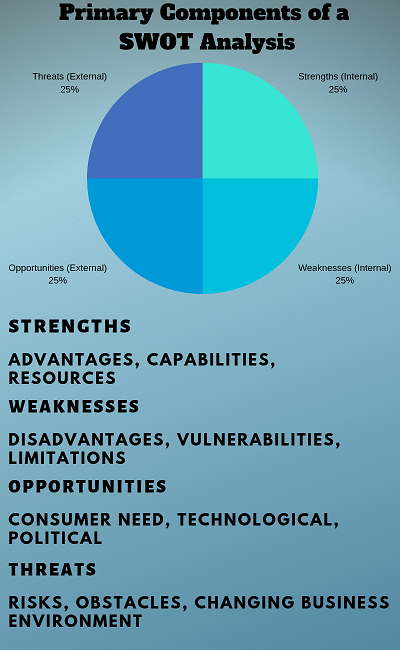
Organizational strategy and business planning requires a solid understanding of the components of SWOT Analysis; where you stand as an organization. SWOT analysis is an acronym for organizational Strengths, Weaknesses, Opportunities & Threats. Strengths and weaknesses refer to the internal operations of the company. The second two letters refer to opportunities and threats. These are in reference to external elements of the business, or the industry environment in which you are competing in. Understanding both the internal and external environment will help organizational decision makers set clear objectives. The following provides an overview of each area of the analysis.
Organizational Strengths (Internal)
Organizational strengths refer to the product or services offered and how they are differentiated. From this perspective, and when analyzing this aspect, you may consider the four "P's" (Product, Price, Place and Promotion) of marketing. Product strengths can occur from a variety of perspectives. It could be cost, price, quality, or you may have an advantage of being the first mover into an industry.
Some questions you will want to ask are;
1) Is your product a substitute or does it have a substitute?
2) Does your product or service have a complimentary product or service?
3) Is your strength your location?
A location can capture significant strategic benefits by capitalizing on local distribution networks within your physical location as well as natural resources, or even the weather.
Organizational Weaknesses (Internal)
Typically a company is aware of what it is good at, its' strengths, and this area generally receives less analysis than organizational weaknesses. Strengths will receive adjustments, but weaknesses require change; and at times a complete overhaul of business direction. When analyzing organizational internal strengths, weaknesses generally reveal themselves. An example of a weakness that may exist within a business is economies of scale. The firms production capacity may be first in class, and it may be able to produce 250,000 widgets a month at a cost that undercuts competitors cost significant margins, but if you can't move the product due to a lack of brand recognition, or a poor distribution network, then this is a serious weakness that requires attention.
Moving to the external environment, one of the primary considerations are business barriers to market entry, as they could present both opportunities and threats to your organizations well being (barriers to entry will be covered in another article).
Industry Opportunities (External)
In the most basic terms, opportunities exist whenever an organization can enter a market with a profitable position. There are three primary opportunities, as follows:
1. filling a consumer need,
2. technological, and
3. political environment
The first, filling a consumer need, is providing a product or service that fulfills an underserved consumer need. For example, if you live in a rural area and there is a lack of Internet service providers. While the infrastructure may exist to provide Internet services, not all rural areas have Internet serivce- this is a clear opportunity to provide that service to the community and because it doesn't exist, there is a potential to mark-up the price due to the lack of competition.
Additionally, being a first mover into the area could instill a loyal customer base instilling brand loyalty, while creating a switching cost (the time involved with changing providers, the inconvenience of getting used to new service provider, etc.). There are numerous benefits in this particular scenario.
The second type of opportunity exists as a result of technology. Technological changes occur and reoccur continuously in the current business and social environment, which consistently presents opportunities for energized entrepreneurs looking for the next great opportunity. Technological opportunities can occur as a direct result of technological innovations, for example app's for a smart phone, or technology can create a need for peripherals, such as scratch resistant screen guards for a tablet.
The final opportunity; political environment. The political environment can create windows of opportunity with changing regulations, shifting focus, and even legislation. An example of opportunities created by legislation is the American Recovery and Reinvestment Act. The decision to create jobs by allocating funds to renovating our infrastructure created opportunities for anyone in those respective industries, but it should be noted that the opportunity lacks longevity, so creating loyalty and establishing relationships is important to last longer than the Act.
Industry Threats (External)
The same elements that create opportunities, create threats. Changing consumer taste/need/desire/wants can sink an established business if it doesn't remain vigilant and find ways to stay in touch with its consumer base. This is illustrated by the numerous closures that have occured over the past several years with brick and mortar businesses; Sears, K-mart, and the struggling JC Penny. This threat is applicable to the technological changes as well.
Just as the changing environment generates opportunities, it also creates threats. As new businesses enter the market and find alternative ways to produce/manufacture goods to compete, such as substitute products, a company that is not remaining vigilant will succomb. Additionally, new regulations and political instability can also have an impact on an organizations well being. Political instability is particularly important to international companies where headquarters may not be keeping up with current events. Political unrest and financial instability can ruin a profitable business.


